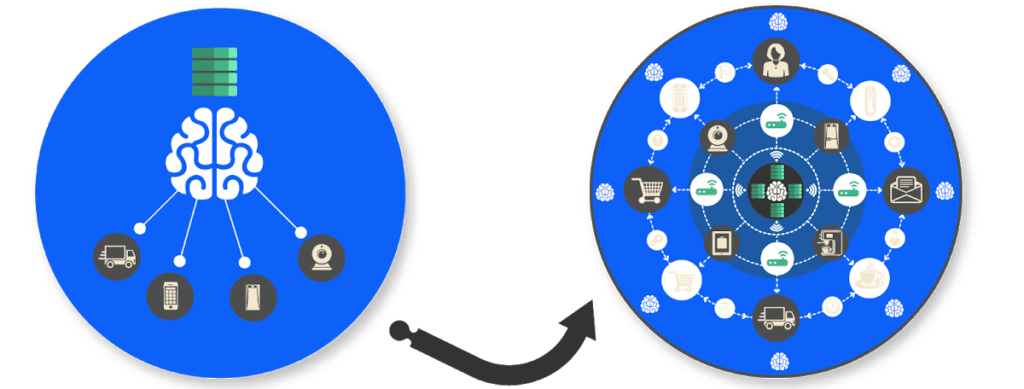
IoT Edge Computing Software
Evolution: Mainframe > Client Server > Mobile/Cloud > Edge
As its name implies, edge computing brings the power closer to the end user application, so instead of devices needing to constantly call home to centralized cloud infrastructure for instructions or analysis they are given the ability to accomplish these tasks on their own.
Together these devices create a massive distributed computing system.

Benefits of this setup include being able to make autonomous operational decisions, gracefully degrade during connectivity outages, and savings on bandwidth volume and costs.
This new evolution has come about due to the shear volume of data and latency required by modern applications like drones and autonomous cars (A self driving car for instance could create up to 4,000 GB of data a day). The trend is enabled by increasingly affordable and sophisticated edge hardware along with advancements in machine learning and on-board GPUs.
The cloud will become a strategically used resource where only the most important information is sent. The cloud can analyze, integrate and the send back only its most important learnings to the edge device in a reciprocal relationship.
In the IoT edge intelligence ecosystem overview below we cover:
- Hardware vendors
- Edge analytics and software providers
- Example use cases
11/01/2019
Edge Software & Analytics
AWS Greengrass
Software that lets you run local compute, messaging & data caching for connected devices in a secure way. With AWS Greengrass, connected devices can run AWS Lambda functions, keep device data in sync, and communicate with other devices securely – even when not connected to the Internet.
Cisco Fog Director
Fog Director delivers the capability to manage large-scale production deployments of IOx-enabled fog applications.
Cisco IOx
The Cisco IOx application environment combines IoT application execution within the network infrastructure; secure connectivity with Cisco IOS Software; and powerful services for rapid, reliable integration with Internet of Things (IoT) sensors and the cloud. By bringing application execution capability to the source of IoT data, customers overcome challenges with high volumes of data and the need for automated, near–real time system responsiveness.
IoT Edge Ecosystem
Industry Groups
Living Edge Lab - We are building a real-world testbed for Edge Computing with leading edge applications and user acceptance testing
ETSI Multi-access Edge Computing (MEC)
The Multi-access Edge Computing (MEC) initiative is an Industry Specification Group (ISG) within ETSI. The purpose of the ISG is to create a standardized, open environment which will allow the efficient and seamless integration of applications from vendors, service providers, and third-parties across multi-vendor Mobile-edge Computing platforms
.EdgeX Foundry
A Linux Foundation project to build a common open framework for Internet of Things (IoT) edge computing and an ecosystem of interoperable components that unifies the marketplace and accelerates enterprise and Industrial IoT.
Examples and Use Cases
Waggle - Waggle is a research project at Argonne National Laboratory to design, develop, and deploy a novel wireless sensor platform to enable a new breed of sensor-driven environmental science and smart city research.
Additional resources
Background Articles
- Data Center Knowledge: Cloud Computing Moves to the Edge - 4/2017
- Edge computing will blow away the cloud - CIO 3/2017
- Moor: A Machine Learning Landscape (PDF) - 4/2017
- New Stack: Where the Cloud Won’t Work: Machine Learning for the Industrial Internet of Things 1/2017
- Business Insider: The next multibillion-dollar tech market was quietly born this year - Peter Levine 12/2016
-
Dell Blog: The Internet of Things (IoT) and Analytics at The Edge - Bill Schmarzo 6/2016
- O'reilly: The edge of the IoT - Joe Biron & Jonathan Follett 4/2016
- Dataversity: Distributing Machine Intelligence to the Foggy Edge of the IoT - James Kobielus 4/2016
- KD Nuggets: IoT Edge Analytics - Ajit Jaokar 9/2015
- Network Computing: Intelligence at the Edge (PDF) - 2/2015
- Wired: The End of Cloud Computing - Peter Levine
- Pervasive Computing: Edge Analytics in the Internet of Things (PDF)
- Fog Computing: A Platform for Internet of Things and Analytics (PDF) 9/2014
Videos / Presentations
- Declarative, Convergent Edge Computation - Christopher Meiklejohn 5/2017
-
IoT Heroes Podcast: IoT, Edge computing, Data and device integration with Sindhu Gangadharan 4/2017
- David Brooks: Taking Machine Learning to Edge Devices - 10/2016
- Wired: The Edge of Computing: It's Not All About the Cloud - 7/2014
- The Smart and Connected Vehicle and the Internet of Things - Flavio Bonomi 6/2013
Research Papers
- The Emergence of Edge Computing (PDF) - Mahadev Satyanarayanan 1/2017
- Quantifying the Impact of Edge Computing on Mobile Applications - Multiple Authors: 8/2016
- Software Architecture Strategies for Cyber-Foraging Systems - Grace Alexandra Lewis 6/2016
- *Paid - Frost & Sullivan: Opportunities in Edge Intelligence Enabling the Interconnection of the Grid of Things - 7/2015
- Cloudlets: at the Leading Edge of Mobile-Cloud Convergence (PDF) - Multiple Authors 1/2014
- Fog Computing and Its Role in the Internet of Things (PDF) - Flavio Bonomi, Rodolfo Milito, Jiang Zhu, Sateesh Addepalli 8/2012
Events
- Cognitive Edge Computing - 10/2016
Notable acquisitions in the space
- GE / Wise.io / Undisclosed 11/2016 Press Release
Difference between Edge and Fog computing?
Within the IoT industry there is a bit of confusion on the use of these two terms. Oftentimes they are used interchangeable and others see a bit of a difference in where exactly the computation is done differently in a Fog or Edge system.
The Fog Computing term was made famous by Cisco with Edge Computing having a longer life. Fog computing can be viewed as having the intelligence at the local area network level of network architecture, processing data in a IoT gateway level, whereas Edge would be seen having the intelligence all the way directly on the edge device itself without necessarily in between.


